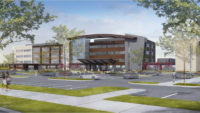The University of Colorado System stretches over thousands of acres with hundreds of buildings on four campuses. Those structures serve some 60,000 students and 4,500 faculty. CU spends millions of dollars each year to maintain and improve existing facilities and build new ones to sustain growth. Recent projects range from upgrading an outdated atmospheric chemistry lab and building new office buildings to a $96-million overhaul and "greening" of the Boulder campus utility system.
While many buildings—student housing, classrooms and offices—require relatively standard construction, many of the university's laboratories and hospitals are among the most sophisticated in the world. In keeping with the system's emphasis on innovation, most upgrades and new construction are built to sustainable, usually LEED standards, and employ construction strategies such as design-build and construction manager/general contractor (CM/GC).
"One thing about CU is their client base," says Gary Constant, vice president of business development and preconstruction services at GH Phipps Construction Cos., Greenwood Village, Colo. "Their customer is every kind of higher education user you can imagine, from student housing to museums, Nobel Prize-winning scientists and leading-edge medical researchers."
Phipps and its predecessor firm, Platt Rogers Construction, have completed jobs on all of the CU campuses, known as the CU System. Gerald Phipps, founder of GH Phipps, worked on the Boulder campus' Farrand Hall nearly five decades ago when he was with Platt Rogers, his uncle's firm.
The CU System has campuses in Boulder, downtown Denver, metro Denver and Colorado Springs. System leaders face many obstacles, from finding funding— which can take longer than expected and delay projects for years—to helping contractors safely navigate tight campus sites.
Creative Financing
Facilities funding, especially, has suffered from Colorado's TABOR, a 1992 amendment to the state constitution designed to curtail government growth by limiting the amount of revenue state and local governments can collect and spend.
"We've got very bad funding," says Bruce Benson, president of the CU System. "To make up for that, we've done things like [successfully lobby for] legislation to get us out of stuff that's superfluous, restructuring all private fundraising, monetizing our intellectual property from research and getting out of the state procurement system."
Just as CU is creative with fundraising, it also creatively extends its sustainability research to its own projects, using new building development and construction strategies studied in its programs.
Working with Colorado state architect Larry Friedberg, the CU System pioneered the state's first design-build contract, which shortens delivery time for projects, and added a local CM/GC program. "He's an innovator, a catalyst," Constant says of Friedberg. CU projects also typically are designed using building information modeling.
"We're always exploring new avenues for accomplishing projects," says Steve Thweatt, University of Colorado Boulder's (UCB) interim vice chancellor as well as its former campus architect and head of design and construction. "We've been on the leading edge in Colorado for promoting design-build. We've developed a whole contract series and used that fairly frequently to accelerate projects and do it in a more cost-effective way."
Boulder
As the system's flagship school, UCB's 786-acre campus, with more than 200 buildings, also has some of its oldest ones—60% will be more than 50 years old in the next few years—as well as some of its most technologically advanced ones. Founded in 1876, UCB ranks as one of the world's top research universities, with programs that run the gamut from climate and energy research to participating in NASA's $670-million Mars Atmosphere and Volatile Evolution mission, which is investigating the Martian atmosphere for possible future manned flights.
Recent UCB construction projects include its just-completed LEED-Platinum Student Recreation Center renovation, built by Saunders Construction Inc. of Centennial, Colo.; residence hall improvements; and ongoing upgrades to the Ekeley Sciences Building, which were approved in 2008 but delayed because of recession-related funding issues. "We have some cutting-edge facilities," says Thweatt. "When people look at the cost of those facilities, they don't always realize the complexity and difficulty of the projects."
Colorado Springs
One of the fastest-growing campuses in the country, the 545-acre University of Colorado at Colorado Springs (UCCS) opened in 1965 and is building or finishing a record $250 million in projects, many of them new construction, according to Brian Burnett, senior executive vice chancellor at UCCS. But UCCS has had to dig deeply and creatively to come up with funding sources.
With its recently opened 54,000-sq-ft Lane Center for Academic Health medical office building, for example, the UCCS campus garnered $4 million of the project's $17 million cost in a donation from the Lane family of Colorado Springs. Other costs are being offset by a rental agreement with the Peak Vista Community Health Centers, which is leasing space in the building.
"We've had to come up with a number of ways to fund capital construction, including private contributions," says Burnett. "We've had to adopt the ways of private education."
Denver Downtown and Metro
The University of Colorado's two Denver-area campuses are the system's newest. Still, the oldest buildings at the Auraria Campus in downtown Denver (UCD), which opened in 1973, are roughly 40 years old and "starting to crater," according to Benson. One of the major facilities at the 227-acre Anschutz Medical Campus (UCAMC) in Aurora—the $644-million, 820,000-sq-ft University of Colorado Hospital—opened in 2007, and the campus is now home to dozens of medical facilities and labs doing research on diseases, from cancer to altitude-related ailments.
UCAMC's 112,000-sq-ft Biosciences 2 design-build bioengineering facility—on which Saunders Construction broke ground in early April—is especially innovative for its public/private collaboration between UCAMC as owner, the Fitzsimons Redevelopment Authority (FRA) as manager and the city of Aurora. It also joins research, business and education functions under one roof.





Post a comment to this article
Report Abusive Comment